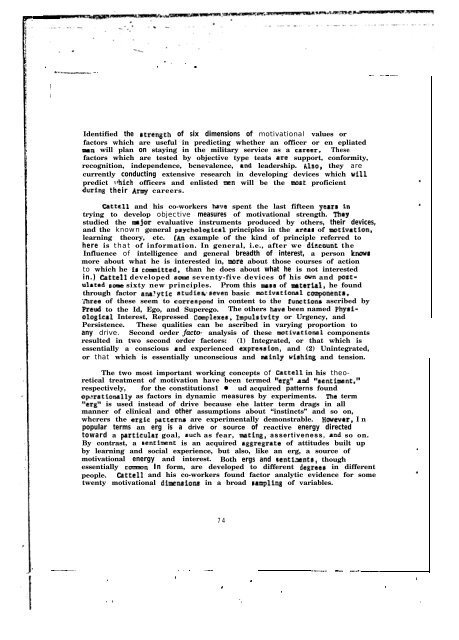Technical Report - International Military Testing Association
Technical Report - International Military Testing Association
Technical Report - International Military Testing Association
Create successful ePaper yourself
Turn your PDF publications into a flip-book with our unique Google optimized e-Paper software.
-. _<br />
. . -<br />
:<br />
;<br />
-.----.-.--.e. .- -<br />
Identified the strengeh of six dimensions of motivational values or<br />
factors which are useful in predicting whether an officer or en epliated<br />
mm will plan on staying in the military service as a career. These<br />
factors which are tested by objective type teats ure support, conformity,<br />
recognition, independence, bcnevalence, snd leadership. ~1~0, they are<br />
currently conducting extensive research in developing devices which ~111<br />
predict cthich officers and enlisted uen will be the nest proficient<br />
dcring their &my careers.<br />
Cattell and his co-workers hsve spent the last fifteen yesra in<br />
trying to develop objective measures of motivational strength. They<br />
studied the amjor evaluative instruments produced by others, their devices,<br />
and the known general psychological principles in the areas of moeivatlon,<br />
learning theory, etc. (& example of the kind of principle referred to<br />
here is that of information. In general, i.e., after we discount the<br />
Influence of intelligence and general breadth of interest, a person knows<br />
more about what he is interested in, more about those courses of action<br />
to which he is comieeed, than he does about what he is not interested<br />
in.) Cattell developed m-me seventy-five devices of his own and poktulatcd<br />
8omf2 sixty new principles. Prom this moss of nnterial, he found<br />
through factor ana?ytic atudies,*seven basic raotivational ccmponents.<br />
ihree of these seem to correepond in content to the functfonr ascribed by<br />
Prcud to the Id, Ego, and Superego. The others have been named Physlological<br />
Interest, Repressed Cmplexes, Impulsivity or Urgency, and<br />
Persistence. These qualities can be ascribed in varying proportion to<br />
any drive. Second order facto- analysis of these motivational components<br />
resulted in two second order factors: (1) Integrated, or that which is<br />
essentially a conscious and experienced expression, and (2) Unintegrated,<br />
or that which is essentially unconscious and mainly wishfug and tension.<br />
The two most important working concepts of Cattell in his theoretical<br />
treatment of motivation have been termed “erg” and “seneiment,”<br />
respectively, for the constitutions1 � ud acquired patterns found<br />
opmationally as factors in dynamic measures by experiments. The term<br />
“erg” is used instead of drive because ehe latter term drags in all<br />
manner of clinical and other assumptions about “instincts” and so on,<br />
whcrers the ergic paeterns are experimentally demonstrable. How?Wr, In<br />
popular terms an erg is a drive or source of reactive energy directed<br />
toward a pareicular goal, nuch as fear, mating, assertiveness, aad so on.<br />
By contrast, a rentiment is an acquired aggregrate of attitudes built up<br />
by learning and social experience, but also, like an erg, a source of<br />
motivational energy and interest. Both ergs and senti;?rants, though<br />
essentially ccmnmn In form, are developed to different degreee in different<br />
people. Cattell and his co-workers found factor analytic evidence for some<br />
twenty motivational dimemions in a broad rampling of variables.<br />
-- _ . . _-._ -.-..___ -_- ___ _ _<br />
.<br />
74<br />
. . -.<br />
.<br />
I<br />
L<br />
.<br />
__.<br />
_.- -.-<br />
.<br />
.<br />
s









